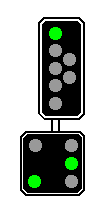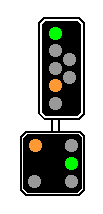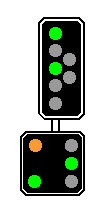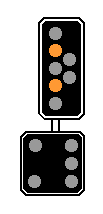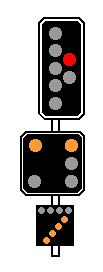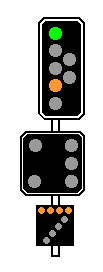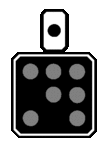Railway Signals in Goyanes: Difference between revisions
20agoyanes (talk | contribs) (Added AVK/TVM430 info) |
20agoyanes (talk | contribs) |
||
| Line 139: | Line 139: | ||
! Meaning | ! Meaning | ||
|- | |- | ||
| [[ | | [[File:V-försignal stopp.svg|175 px]] | ||
| style="width:100px" | '''Expect Crossing Not Secured<br/>(Crossing not clear)''' || The Main RCS signal is at danger, the driver must slow the train down immediately and attempt to stop before the crossing. Emergency brake application is acceptable. | | style="width:100px" | '''Expect Crossing Not Secured<br/>(Crossing not clear)''' || The Main RCS signal is at danger, the driver must slow the train down immediately and attempt to stop before the crossing. Emergency brake application is acceptable. | ||
|- | |- | ||
| [[ | | [[File:V-försignal rörelse tillåten.svg|175 px]] | ||
| style="width:100px" | '''Expect Crossing Secured<br/>(Crossing clear)''' || The Main RCS signal is showing secured, proceed normally. | | style="width:100px" | '''Expect Crossing Secured<br/>(Crossing clear)''' || The Main RCS signal is showing secured, proceed normally. | ||
|} | |} | ||
Revision as of 03:39, 10 April 2020
This article is incomplete because it is pending further input from participants, or it is a work-in-progress by one author. Please comment on this article's talk page to share your input, comments and questions. Note: To contribute to this article, you may need to seek help from the author(s) of this page. |
| This article is in work in progress. Any information here may not be final as changes are often made to make way for improvements or expansion of lore-wise information about Goyanes. Please do not edit anything here without the consent of the article's creator. The article's creator is Goyanes (alternate: 20agoyanes). |
Railway signals in Goyanes evolved from electro-mechanical semaphores that changed position to indicate track block status. Before then though, railways employed “track officers” to manage sections of track using hand gestures, line-of-sight techniques, and physical tokens that had to be passed from train to officer and vice versa. This was wildly inefficient, and as the railways grew, technologies were developed to reduce collisions and improve railway safety. Starting with the Grand Trunk Railway and spreading quickly around the nation, electric track circuits that controlled semaphore signals began to take hold. The process started in the 1870s, but by the 1890s, Goyanes’ railway network was fully electro-mechanically signaled.
In 1902, the Stortoghass Tunnel Crash in Gojannesstad occurred, where a trough train engineer running a service from the Hysende-Osanhalt-Kongsland Railway onto the grand trunk in Gojannesstad became confused by the Grand Trunk's signal system, and crashed the train, resulting in 30 deaths and more than 50 injuries. This caused the Ministry of Transportation (then known as the Ministry of Railways) to mandate a new, unified, national signal system. The new signal system became known as M-Class signals (M-klassesignalen). M-Class signals used semaphores and relays, and a unified set of meanings. This helped promote inter-operation, and created a stanrdized and safer working environment for the railways.
By the early 1930s, the Ministry of Railways had consolidated all of Goyanes' railways into four companies, the Grand Trunk, the Hysende-Osanhalt-Kongsland, the Nordstrom Seabord, and the Hirendag Road. As part of this consolidation effort, a new signalling system based on color-light aspects was introduced. This became known as the L-Class signals (L-klassesignalen). The L-Class also introduced a new safety system known as ATS-M. ATS-M uses electromagnetic induction to warn the driver that they have passed a cautionary aspect, and stop the train if a signal has been passed at danger. The ATS-M system, in addition to L-Class signals are still used on all classic lines today.
The devolopment of the HHT system in the 1960s and 1970s forced Gojan Jårnbaner, Goyanes' state railway operator, to develop a cab signalling system. The high speeds of the HHT system prevented operators from being able to see and comprehend any trackside signals, so a system that transmits speed and track information directly to the driver was created, known as AVK. AVK is currently on its second iteration. In addition, a new system known as HBK that uses train-mounted microprocessors and track-mounted beacons to enforce speed limits set by both track conditions and signal state. HBK is installed on all classic lines in Goyanes.
In the 1990s, in an effort to modernize and increase frequency on Goyanes' classic lines, AVK was installed on certain classic lines to increase frequency. In additon, a new signalling system that was able to understand and adapt to the abilities of more modern rail equipment (high speed switching points and quicker braking curves on trains). This system became known as the A-Class signals (A-Klassesignalen).
Currently in Goyanes, all signals are either L- or A-Class, all classic lines and trains are equipped with HBK, and high-speed trains and lines are equipped with AVK. The introduction of A-Class signals did not completely phase out L-Class signals, and retrofitting is done on a per-line basis, with higher-throughput lines getting switched over first, and lesser used primary and secondary lines later. About half of the classic network still uses L-Class signals.
L-Class Signals
Signals in Goyanes are based on the distant-main block system. Distant signals (Vørsignalen) alert the driver to the aspect of the next main signal (Hovedsignalen), so that the driver may act accordingly in time for the main signal. Both L- and A- type signals may be used for main line traffic up to 160 km/h. Above 160 km/h national regulations require the use of cab signalling.
Main signals (Hovedsignalen) are called so because they can display a stop aspect. If the stop aspect shows, it may not be passed without authorization, and is therefore considered a very important point in the track layout. Therefore, they earned the name "main signal." A main signal can be recognized by its rectangular shape. They may contain either one or two vertical rows of lights, however they will always be taller than they are wide.
Main signals are used at several places along the lines. They are used at the entrances to stations, at which point they are called "home signals" (Hussignalen), at the exits of stations, where they are called "exit signals" (Utgangsignalen), so break the track signals into blocks, and to guard interlockings. For the latter two they are simply known as main signals. After the introduction of the A-Class signals in 1990, certain changes were made to the L-Class for safety purposes. First, home signals will display a board over the signalhead with the letters "HUS" on them, and some signals protecting interlockings were retrofitted with a board depicting a white diamond on a black background.
Distant signals (Vørsignalen) announce to the driver what will be shown to the driver at the next main signal, thus their name. A distant signal cannot stop a train, but they can slow one down in time for a stop signal or a diverging set of switch points. Distant signals are always square-shaped. For there to be a distant signal, there must either be a main signal or an end of track. However, you do not need a distant signal attached to a main signal. For any tracks (always secondary lines) where the speed limit is less than 40 km/h or of the railway uses cogs in the center of the track (alpine routes), the use of distant signals is optional, however once the track speed is above 40 km/h, use of distant signals is mandatory.
Distant signals can be mounted allong with a main signal on the same mast. The distant signal must be mounted below the main signal on the mast. Distant signals are only mounted on the main signal if the next block is 1200 meters or less. If it is more than 1200 meters, there will be a separate distant signal before the main signal it protects.
The following graphics show main signals with the distant signals that announce them mounted below. In most circumstances the next signal aspect displayed by the distant signal would be different. In addition, the main signals shown have the capability of displaying all aspects. In most circumstances, main signals can only display certain aspects that relate to the condition of the lines they protect, and as such could have as few as three or four lamps, instead of the seven pictured here. Regardless, the light and color combinations carry the meaning, not the total amount of bulbs on the signalhead.
A-Class Signals
By the end of the 20th century, it became apparent that Goyanes' L-Class signalling system was not adequate for modern rail travel. The braking curves that were integrated into the system were designed for steam and early electric locomotives that took much longer to brake and accelerate. In addition, railway technology had advanced, and by now, switchpoints had been constructed with the ability for high-speed transit, making the previous aspects useless in some areas.
Regarding braking curves, by 1980 there were 160 km/h trains in operation on classic lines. With the next possible speed downgrade on the L-Class system being to 90 km/h, it represented a waste of time to slow trains down to 90 km/h to transit a switch that coupld have been passed at 120 km/h. Upgrading the L-Class system with more aspects would have made the system more complicated and difficult to understand, so Gojan Jårnbaner decided to design a new signalling system for the future of the network.
The new requirements of the system were more fine-tuned braking curves, and an easier to understand color-light system for the drivers. The previous L-Class had been based on mechanical semaphores, and training was easy when drivers already understood the semaphores. However, now that they were gone, the system became increasingly more complex to explain. As a result a much simpler system had to be developed.
The new system that was developed was easily integrable into the L-Class network, and used principles of the K-System, where distant and main signals were combined on certain signals, which was already familiar to drivers. The system was designed by engineers, and used high-school students as a control group in addition to drivers to ensure that the system was easy enough for novice drivers to understand, while still maintaining all the needed design features.
As all A-Class signals can display both a distant and a main signal aspect, several changes had to be made. The first, signals that had no ability to display stop using a light have square borders. The second, signals protecting station entrances (home signals) display a board that says "HUS" over the signalhead to indicate it is a home signal. Third, signals protecting interlockings have a board over the signalhead that shows a white diamond over a black background. The latter two have been incorporated into the L-Class signals.
Similarly to the L-Class signals, if a block section is more than 1200 meters, there will be a separate distant signal that uses a square signalhead before the main signal. Otherwise, standard round signalheads can represent upcoming changes in the signal state.
Shunting/Dwarf Signals
Shunting signals, also known as “dwarf signals” (kleinesignalen), are used for shunting purposes in yards. They are smaller in size, and use only white aspect colors. They may be placed on top of a half-height post, or placed at the same height as the trackbed.
Railroad Crossing Status (RCS) Signals
RCS signals (Vagersignalen or VS) are used to indicate to the driver the status of a railroad crossing ahead on the line. Various factors affect the aspect displayed. The most simple kinds simply confer if the gates are closed and locked, but the most advanced types rely on sensors that can detect if vehicles are stalled on the crossing, in addition to detecting whether or not they have been locked. There are two types of RCS signals, just like color-lights, they are Main Signals and Distant Signals. Main RCS signals are identified by a “V” sign under the bulbs. Distant RCS signals are identified by their shape and unique bulb layout.
A related signal called a Bridge Status Signal (Bryggesignalen or BS) uses the same signalheads and aspects, except the main BSS signals have a "B" signpost under the signal head, similar to how main RCS signals have a "V" signal on them.
Main RCS Signals (Hovedvagersignalen/HVS)
Distant RCS Signals (Vørvagersignalen/VVS)
AVK System
The AVK system was invented in the 1960s and 1970s for use on the HHT high-speed services, as operators would not be able to read and interpret lineside signals at high speed. AVK-1 was the first iteration of the system invented, with the second and current iteration being known as AVK-2. Signaling information is instead transmitted to the train and displayed as part of the train controls. The driver is shown the safe operating speed, displayed in kilometres per hour. The 1980s-developed AVK-2 system transmits more information than traditional signalling would allow, including gradient profiles and information about the state of signalling blocks much further ahead. This high degree of automation does not remove the train from driver control, although there are safety mechanisms that can safely bring the train to a stop in the event of driver error or incapacitation.
History
The AVK system was developed by Gojan Jårnbaner engineers in conjunction with the Eindrisson company, which currently markets the system worldwide. It was first tested on several conventional lines to ensure the system would work when transfered over to the high-speed lines. The AVK-1 system went online in the first section of the HHT system to open, the Gojannnesstad-Naderfjord high-speed railway.
By 1988, in addition to the creation of the A-Class signal system, the engineers decided to improve the AVK system with new microprocessors both onboard and trackside, and a new, more computerized (although partly relay-based) trackside system. The new system was called AVK-2. AVK-2 was marketed by Eindrisson engineers as part of a multi-tiered approach. AVK-2 would be standard operation (cab signalling and automatic train protection from overspeed and stop signals), AVK-2.1 (optional automatic train control), and AVK-2.2 (fully automatic operation).
In 2010, the AVK system was applied on certain classic lines to test throughput capacity. It proved successful and now, certain very-high capacity lines have had the AVK-2 system installed to increase frequency of trains.
Implementation
The line is divided into signal block sections of about 1,500 metres (or less on classic line applications), the boundaries of which are indicated by blue square signs printed with a yellow-on-white triangle. A digital display on the train driver's dashboard shows the maximum permitted speed for a train's current block, as well as a target speed based on the status of the line ahead. The maximum permitted speed is based on factors such as the proximity of trains ahead (with steadily decreasing maximum permitted speeds in blocks closer to the rear of the next train), junction placement, speed restrictions, the top speed of the train and distance from the end of the high-speed route. Trains at high-speed take several kilometers to stop. Since trains will require more than one signal block to slow down, drivers are alerted to reduce speed gradually, several blocks before any required stop.
The signalling system is permissive; the driver of a train is permitted to proceed into an occupied block section without first obtaining authorisation. Speed in this situation is limited to 30 km/h and if speed exceeds 35 km/h, the emergency brake is applied and the train stops. If the board marking the entrance to the block section is accompanied by a sign marked N, the block section is not permissive, and the driver must obtain authorisation from the dispatcher before entering the block. Once a route is set, or the dispatcher has provided authorisation, a white lamp below the marker board is lit to inform the driver. The driver then acknowledges the authorization using a button on the train's control panel. This temporarily overrides the emergency braking system, which would otherwise stop the train when proceeding past the non-permissive marker's ground circuit.
When trains enter or leave the high-speed line from classic lines, they pass over a ground circuit which automatically switches the driver's dashboard indicators to the appropriate signalling system. For example, a train leaving the high-speed line onto a classic line would have its AVK signalling system deactivated and its traditional ATS (automatic train stop) and HBK (automatic speed control) systems activated by the train's onboard computer at the boundary point.
Electronics
Although AVK is one of the most advanced signaling systems in the world, some components still function on relays instead of solid-state electronics. This has not proved to be an issue yet, as Eindrisson still manufactures relays for the AVK system.
There are two components to the AVK-2 system: one ground-based, the other on board the train. Both run using Polykor processors, and are programmed in a safety-critical coding language known as P-A, made by Polykor. The system makes extensive use of redundancy; the mean time between dangerous failures is estimated to be over 1 million years, according to Eindrisson.
The ground-based segment of AVK-2 resides in trackside equipment boxes, which control stretches of track about 15 km long. Each one is linked to the line's centralized traffic control center, and directly controls about ten blocks of track, each with its own track circuit. Signaling information is encoded in AC signals which are fed into the rails of each block. There are four different carrier frequencies available in AVK-2, and they are used alternately in pairs on both tracks of the high-speed line. On one track, blocks use alternately 1,700 Hz and 2,300 Hz, while on the other track blocks use alternately 2,000 Hz and 2,600 Hz. Upon these carrier frequencies can be modulated 27 separate audio frequencies, any combination of which can be present at one time; the earlier AVK-1 used eighteen separate frequencies, only one of which could be present at any time. Each block has a receiver at the opposite end to the transmitter, and the loss of the track circuit signal (owing to shorting by train wheels or due to a failure such as a broken rail) is interpreted as an indication that the block is occupied. Signalling block boundaries are equipped with electrical separation joints that prevent adjacent blocks from interfering with each other, whilst still letting the traction return current (at 50 Hz) pass through.
The signals which are present in the rail are detected by antennas mounted underneath the front snowplow of HHT trains, about 1 meter forward of the front axle. These antennas work by inductively coupling to the AC signal shunted between the rails by the first axle. There are four redundant antennas per train, two at each end. Only the two at the "front" of the train (in the direction of travel) are used. The signal from the track circuit is filtered, conditioned, and decoded on board the train by two redundant digital signal processors.
TThe signal sent takes the form of a 27-bit "word." These 27 bits of information are used as an input to the train's signalling computer, the onboard part of the AVK-2 system. In older versions of AVK, the target speed was updated only at every block boundary, resulting in a "staircase" style speed profile which is not representative of the continuous speed changes effected by the driver. However, with the additional information of block length and profile, AVK-2 is able to generate a continuously varying target speed through calculations performed in the onboard signalling computer, thus giving a much more realistic (and comfortable for the passenger) speed profile of continuous acceleration or deceleration for the driver to follow.
In addition to the continuous speed control afforded by AVK-2, single instructions can be passed to the train by inductive loops located between the rails, which couple to a corresponding sensor under the train. Using the same frequency encoding principle, 28 bits of information can be recovered from a beacon, at speeds up to 400 kilometres per hour. They come in two lengths depending on the line speed, 7 metres and 4.5 metres. They consist of two half loops, which together transmit the message via a 125 kHz frequency, phase shifted with a 62.5 kHz carrier frequency. The information passed along concerns a variety of events or actions, such as signal system changes at the entry or exit of a high-speed line, arming or disarming the AVK-2 system, closing air vents before entering a tunnel at speed, raising and lowering the pantographs, and changing the supply voltage at system barriers.
Oversight
A "black box" similar to an aircraft flight data recorder, passively watches over the entire process, monitoring a variety of parameters and recording the events onboard the train. In AVK-2-equipped trainsets, older paper-strip recording equipment has been replaced by a digital recording system. Every action taken by the driver (throttle, brakes, pantographs, etc) as well as signalling aspects (for AVK-2, and conventional signals (via the ATS and HBK signals) are recorded on magnetic tape for later analysis using a desktop computer.
Another system, known as FK, oversees the driver's alertness. It consists of a foot pedal control that the driver needs to hold down for the HHT trainset to move. This pedal must be released then re-pressed once every 60 seconds if no other activity takes place. If no activity takes place, a buzzer will sound reminding the driver to release and re-press the pedal. If the pedal is still not reset, the emergency brakes will activate. The pedal can be released for a very short period of time before the buzzer sounds and the saefty timer activates the emergency brakes.
A small amount of overspeed allowance is allowed before the AVK system will activate the emergency brakes. Below 80 km/h, the tolerance is 5 km/h. Between 80 km/h and 160 km/h it is 10 km/h. At speeds in excess of 160 km/h, it is 15 km/h. If the speed is in the tolerance speed, an overspeed warning buzzer sounds, and is not deactivated until the speed goes below the limit speed again. If the speed exceeds the safety tolerance the buzzer switches to an alarm and the emergency brakes apply. The alarm does not switch off until the train comes to a complete stop.
Cab Display
In the centre of the driver's desk in an HHT cab, or on any other AVK-equipped train, just below the windscreen, there is a double or triple row of square indicators. This is where target speeds for the current and subsequent blocks are displayed to the driver, in the form of numbers (in kilometres per hour) on a colour-coded background. Full line speed is indicated in black numerals on a green background, while slower aspects are indicated in white numerals on a black background. A full stop is indicated as "000" on a red background. Decreases in speed are indicated with black numerals on a white diamond background. Below this display is the speedometer, where the continuously varying target speed is indicated as well as the current speed. Speed is measured by the train's redundant tachometers to a precision of ±2%. The allowable variation between target speed and actual speed is dependent on speed.
All the in-cab signalling displays must be very reliable, since they are critical to safety. They have relay-based position sensors which feed back to the signalling computer the current aspect being displayed to the driver. If there is a failure in the display unit, appropriate action is taken to stop the train.
In order to reduce stress on the driver, speeds are displayed over several blocks ahead of the train. When a block is followed by a more restrictive (slower) block, the display for that block flashes so the driver can better anticipate the speed change without releasing the brake. Restrictive indications can only be updated at block boundaries, except in emergencies. They are accompanied by an audible in-cab horn signal. Restrictions can however be lifted at any time within a block.
AVK-2 has extensive redundancy built into it, and one might wonder why it is not used to control the train directly. However, keeming in mind the lack of adaptability of the system to unexpected situations, it is considered desirable to retain a human in the loop. Driving an HHT is therefore done entirely manually, but the signalling system keeps a very close watch to ensure maximum safety.
Below is a chart of the cab signal aspects and the meanings they confer.
Automatic Train Stop (ATS)
Automatic Train Stop (Automatisk Togstanna/ATS) is a system that governs color-light signals that are in danger. The current ATS system (ATS-M) was invented at the same time as AVK-4H to protect lines that would use only the normal signal system. Previous ATS systems relied on mechanical infrastructure, such as tripcocks opening brake valves when a signal was passed at danger. Such systems still exist on select railways, such as the Gojannesstad U-Baner, among others. However, on the GJ network, the ATS-M system is operational. It functions on a permanent magnet placed at the center of the track at the end of the safety overlap, several meters past the signal, with an electromagnet placed immediately afterwards in the direction of travel (placed on both sides in omnidirectional lines). When the signal is at danger, the electromagnet shuts off. As the train passes over the magnet, a sensor is tripped by the permanent magnet, and a grace period of about 2 seconds activates. After the expiration, the ATS system sounds a warning alarm, shuts off power and activates the emergency brake.
However, when the signal is clear, the electromagnet turns on (a failsafe, if power is cut to the electromagnet the train is stopped). When the train passes over the permanent magnet, the grace period activates, however the electromagnet untrips the sensor on the train, switching off the ATS system, and sounding a chime in the cab. This allows for positive feedback to remind the driver they have passed a clear or caution signal, and are OK. The system can be either uni- or bi-directional. Bi-directionality is achieved by installing the electromagnet on both sides of the permanent magnet, allowing both directions to use it properly. On uni-direction track, the ATS magnet may be mistakenly tripped by trains going the opposite direction with authorization. In such cases a signboard is shown to override the ATS system.
The ATS-M system may be overridden (in case of a shunting signal allowing access) by holding down the override button as the train passes over the magnet. Mechanical ATS systems such as on the U-Baner cannot be overridden except by dispatch due to the nature of the system.
Driver Reminding Apparatus (DRA)
The DRA (Førermann Påminnelsemasjin/FPM) is a memory device used as an extra safety net aboard trains. Its use was mandated after the 1995 Ragnarfjord Train Crash, in which 30 people died because a driver passed a signal at danger after stopping within the safety overlap at a station platform (the signal head was not visible from the cab).
The DRA functions as a kill switch for traction on the train. It is a two-position switch, on and off. When the DRA is set, traction power is disconnected for the train. Railway regulations stipulate that the DRA must be set when shutting a train off, entering or exiting the cab, when the train has stopped for a signal at danger. The DRA may only be turned off when the train has authority to proceed (i.e. the signal clears), the driver has authority to turn on the train, or when the driver has been granted authority to pass a signal at danger by a shunting signal or by radio orders from dispatch.


